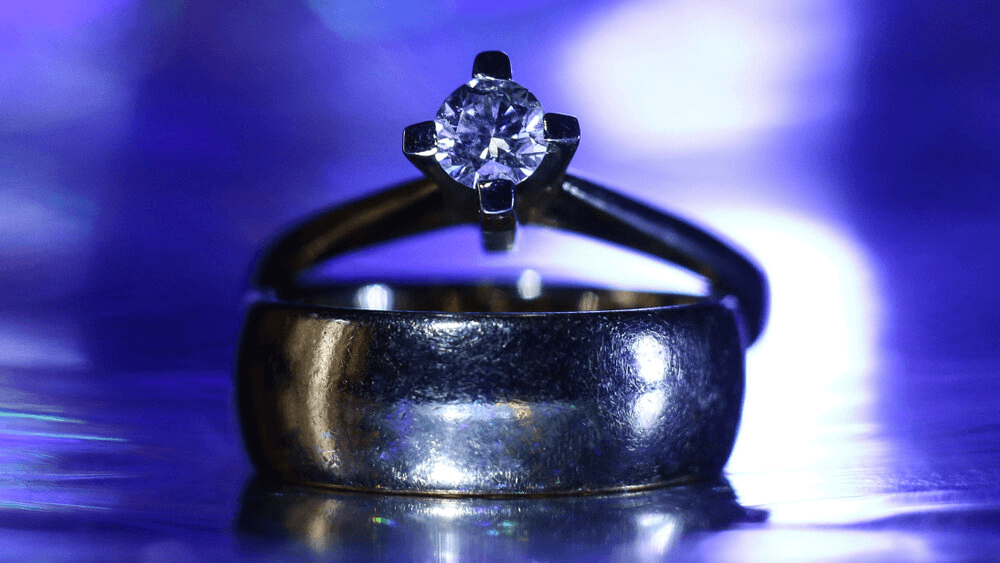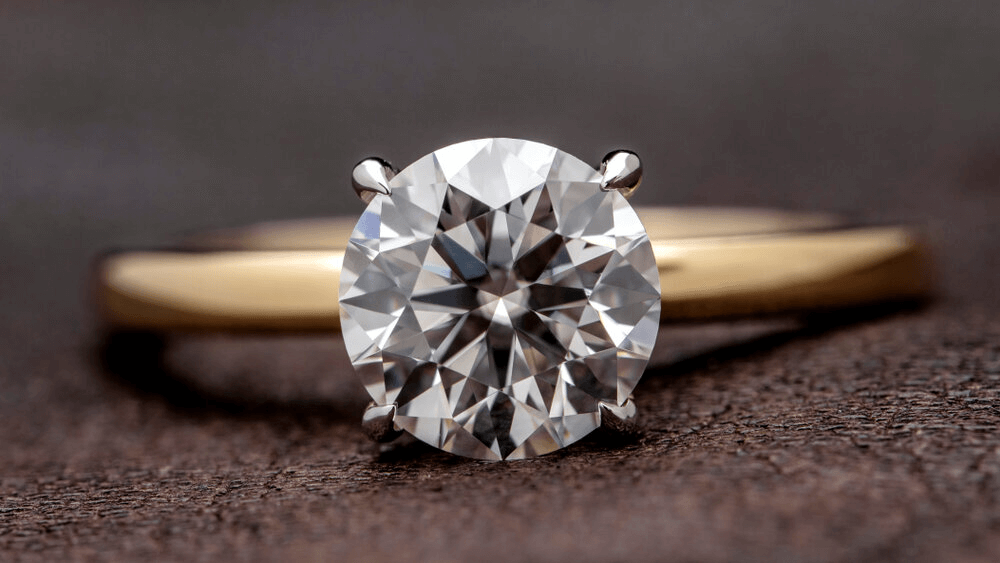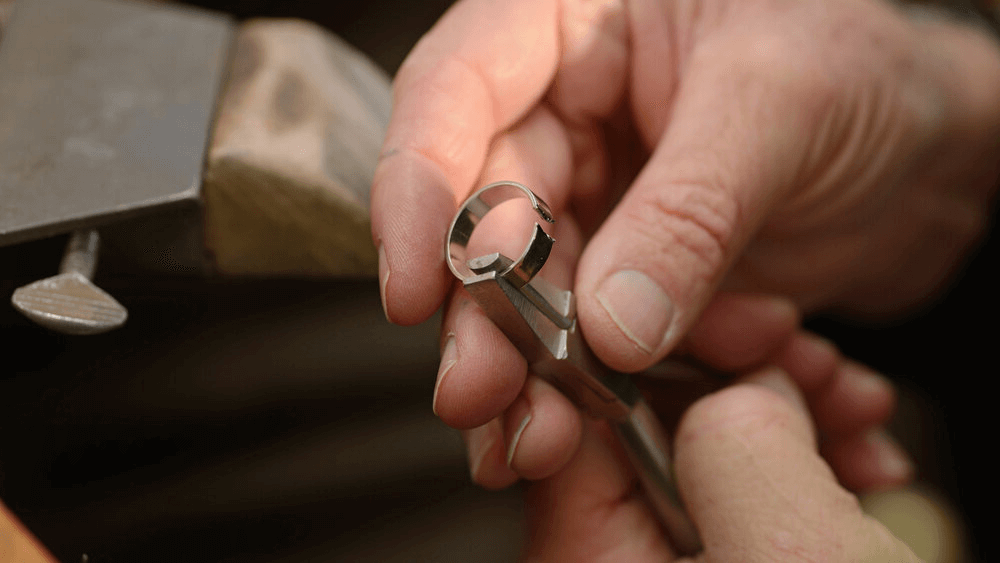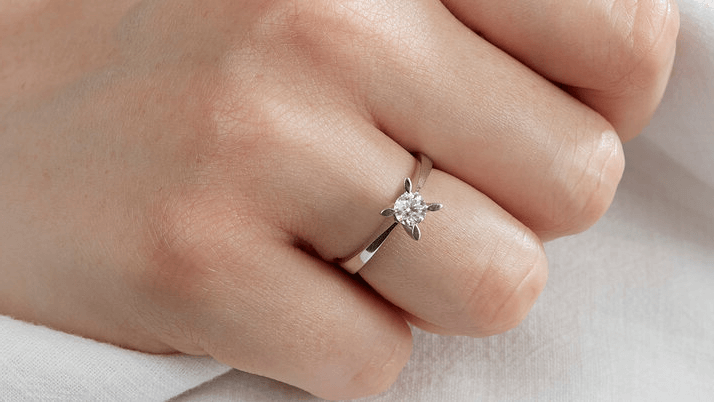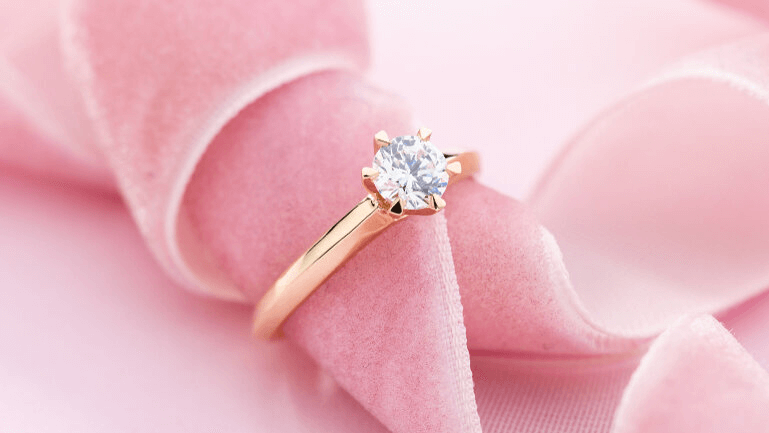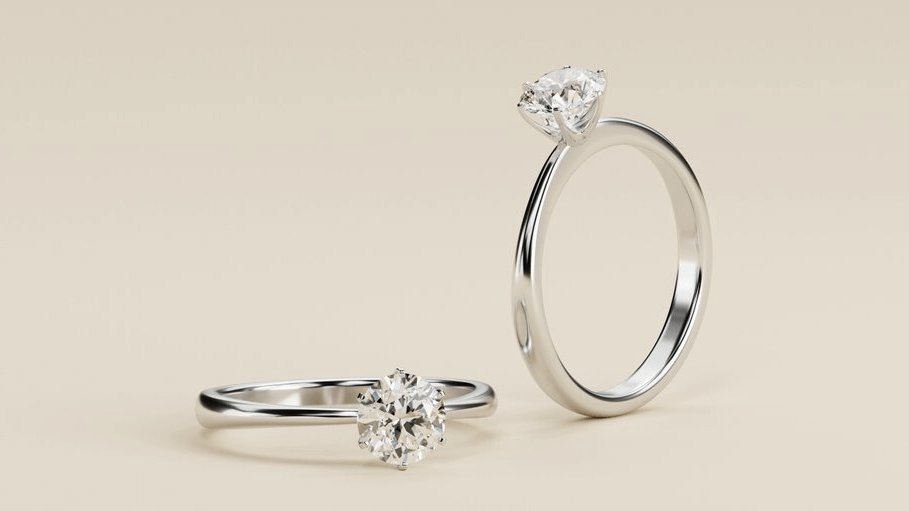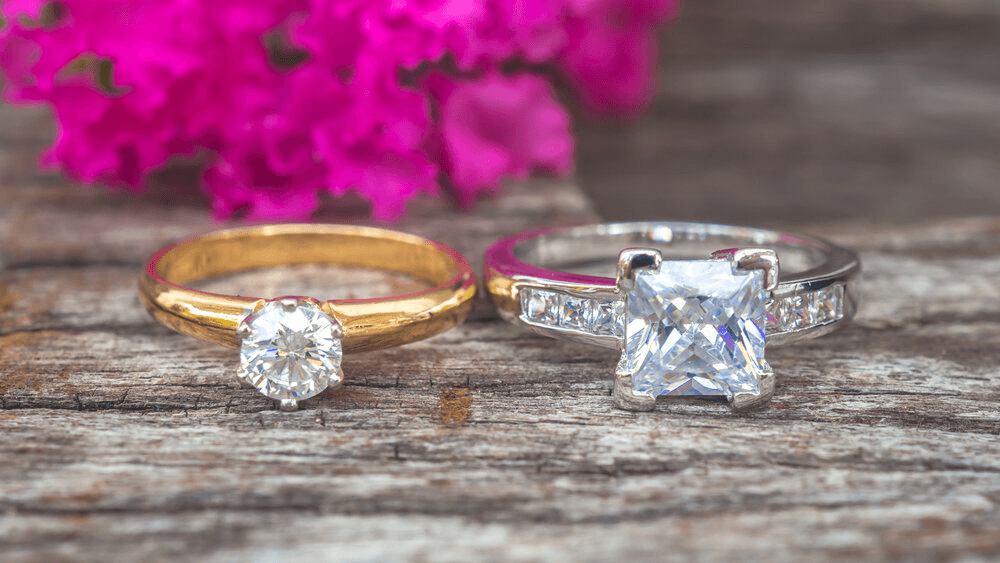How to Choose the Perfect Gold Engagement Ring That Lasts a Lifetime!

By Gary A.

Edited by Olivia H.
Published Dec 24, 2021
Edited on Dec 18, 2024
Balancing tradition and personal style, a gold engagement ring offers timeless elegance, but choosing the right one involves more than just picking a color—it’s about finding the perfect blend of durability and design.

Navigate this guide:
- 6 Quick Tips for Buying a Diamond Engagement Ring in Gold
- Introduction to Gold Engagement Rings
- Understanding Gold Purity and Alloys
- Choosing the Right Carat for Your Engagement Ring
- Gold Color: Yellow
- Gold Color: Rose Gold
- Gold Color: White Gold
- Ethical Considerations in Gold Sourcing
- Gold Wedding Bands
- Maintenance and Care of Gold Rings
- Our Expert Take
- 7 FAQs
Before we dive deeper into the specifics, here are some practical tips to help guide your decision-making process:
6 Quick Tips for Buying a Diamond Engagement Ring in Gold
- Tip 1:Understanding Gold Purity and Color: Pay attention to the karat of gold, as it influences both appearance and durability. Remember, 24K is pure gold, but softer. 14K or 18K gold is often ideal for a balance of purity and strength. Choose the color of the gold (yellow, white, or rose) based on personal preference and how it complements the diamond. Yellow gold offers a classic look, white gold is contemporary and silvery, while rose gold adds a romantic hue.
- Tip 2:Evaluating the Diamond’s Quality: Examine the 4Cs – Cut, Color, Clarity, and Carat. A well-cut diamond maximizes brilliance. For gold settings, a slightly lower color grade (H or I) can still appear colorless and offer better value. Inspect the clarity under magnification. Look for a stone that appears clean to the naked eye, understanding that minor inclusions can reduce cost without compromising beauty.
- Tip 3:Ring Design and Setting: Consider the ring design and how the gold setting complements the diamond. A prong setting showcases the diamond well but requires more care, while a bezel setting offers more protection. Think about the wearer’s lifestyle. If they are active or work with their hands, opt for a more secure and less protruding setting.
- Tip 4:Gold Alloys and Skin Sensitivity: Be aware of gold alloys, especially if the wearer has sensitive skin. Alloys like nickel can cause allergic reactions. For sensitive skin, higher karat gold or hypoallergenic alloys are preferable.
- Tip 5:Longevity and Maintenance of the Ring: Consider the long-term durability and maintenance of the gold engagement ring. Higher karat gold rings may require more frequent polishing to maintain their luster, while lower karat rings are more resilient to wear and tear. Regular cleaning and occasional professional servicing can keep the ring in pristine condition.
- Tip 6:Matching with Wedding Bands: When selecting a gold engagement ring, think ahead to the wedding band. It’s important to choose a style and color of gold that will complement or match the future wedding band. Some couples prefer a perfectly matched set, while others opt for contrasting styles or colors for a more unique look.
Now that you’ve got these practical tips, use Jeweler AI below to find the perfect engagement ring that suits your style and budget:
Introduction to Gold Engagement Rings
Of all the precious metals, gold is the one that needs the least introduction. Distinctive, bright, and the core of so many of history’s most pivotal moments, gold’s emotional and sentimental value is even higher than its financial value.
There’s no denying that its importance for engagement rings and wedding bands is well-known already, but a lot of people are surprised to discover how much there is to learn about gold before they are able to settle on the right design for their rings.
Here is everything you need to know.
Understanding Gold Purity and Alloys
From ‘alloy’ to ‘zinc’, here’s the A-Z of gold that any first-time shopper will want to learn inside and out before they buy for the first time.
What is Gold Alloy?
Put simply, a combination of gold with one or more other metals capable of giving the gold strength, and altering its color.
If you remember anything from high school chemistry, you might remember that the term ‘alloy’ refers to a combination of two or more different elements. Steel, for instance, is not a naturally occurring metallic element; it’s an alloy of iron and carbon.
Pure gold, also referred to as 24K gold, is very soft – so soft that it can be bent and scratched with very little effort. It’s not something any jeweler will want to use in the creation of an engagement ring, wedding band, or any other piece of wearable jewelry.
Some of the most common alloys for gold include silver, copper, nickel, palladium, and zinc.
There is more than one way of alloying gold, and the different gold alloys are represented by ‘karat types’…
Deciphering Karat Types
The most common karat types for fine jewelry are as follows:
- 22 karat gold, meaning a gold-to-alloy ratio of 22:2> This is generally considered far too soft to be used in most pieces of jewelry and particularly pieces that will be worn on a daily basis.
- 18 karat gold, meaning a gold-to-alloy ratio of 18:6
- 14 karat gold, meaning a gold-to-alloy ratio of 14:10
- 10 karat gold, meaning a gold-to-alloy ratio of 10:14
This means that, while a 22 karat gold ring and a 10 karat gold ring may be exactly the same size, they will feature drastically different levels of gold.
This also means that two solid gold rings of different karat types can look totally different from one another – but more on that below.
Solid Gold vs Pure Gold
Solid gold refers to jewelry – or any other item – made entirely from gold, rather than being gold plated or gold filled. It can apply to any karat type, so shouldn’t be confused with 24 karat gold specifically.
It’s understandable that some shoppers get mixed up between the terms ‘pure gold’ and ‘solid gold’, since a 10 karat gold ring features more alloy than actual gold, but there is a major difference between the two.
When it comes to bridal jewelry, solid gold is the only option you should be looking at. It means that your ring will be capable of withstanding decades’ worth of wear, rather than just a few months or years.
You’ve probably heard of gold plating before – a common practice for lower-cost pieces of jewelry, which uses only a very, very thin layer of gold over another metal, like sterling silver. The result is much less expensive, since much less gold is used.
New gold plated jewelry is visually indistinguishable from solid gold jewelry but, if the piece is worn regularly, the wearer will eventually notice the gold plating wearing away and exposing the metal underneath. This means that gold plating is okay for pieces that will be worn once in a blue moon, but not for jewelry that is meant to last the wearer the rest of their life.

Choosing the Right Carat for Your Engagement Ring
It’s not hard to feel drawn-in by gold. Not only is it beautiful, but it’s got some pretty strong connotations for romance and commitment that span thousands of years of human history. But is it right for popping the ultimate question?
Gold’s emotional significance is as powerful as its significance for wealth and status. A symbol of endlessness and richness of spirit, it offers a beautiful setting for your diamond – and one that creates an attractive contrast between the colorlessness of the stone and the natural warmth of the metal.
Different Karat Types for Engagement Rings
Most engagement rings feature either 18 karat gold or 14 karat gold, with the latter representing the most popular option.
Chances are that your options will be easily whittled down to these two.
Why? Because 22 karat gold, as we mentioned above, still features such a high ratio of gold to alloy that the metal will still be very soft, and very vulnerable to damage. 10 karat gold, on the other hand, features more alloy than it does gold; the result, while very strong and durable, is a metal with a very weak, pale color that many shoppers find disappointing.
Our guide to 14K vs 18K gold offers a lot more insight on the subject. There are advantages and disadvantages to both, and you’ll want to get your head around these before you commit to either one.
Gold and Skin Allergies
People with allergies to common alloys, such as nickel and zinc, should be careful when selecting gold for their jewelry.
It may be the case that a higher karat gold – like 18K – works best for the wearer’s skin, and this is considered one of the biggest advantages of this karat type.
The key thing to note here, however, is the fact that this may work for some people, but not for others. If you’re picking out an engagement ring on behalf of your girlfriend, consider the metal her existing jewelry collection is primarily made from (something you should be doing anyway). Does she wear gold, or avoid it in favor of allergy-friendly metals like platinum? If she does wear it, is it hallmarked as 18 karats?
It’s rarely a good idea to invest in a gold engagement ring if your partner obviously prefers sterling silver and platinum, particularly if that preference is driven (at least in part) by an allergy to certain metals.
Gold Color: Yellow
Diamonds can be transformed with the right setting. Even the diamond solitaire, a staple for any jeweler, will look totally different with a simple change of metal. Here’s what you need to know.
Combining Yellow Gold with White Diamonds
Gold is highly versatile, and its natural warmth is perfect for bringing out the brightness and colorlessness of your diamond.
Take a look at this Oval Solitaire in Yellow Gold, which offers a perfect example of the innate power diamond and gold. While the design is relatively basic, it remains one of the most popular choices for engagement rings, since the natural beauty of the yellow gold is capable of highlighting the most captivating aspects of the stone: its fire, brilliance, scintillation, color, cut and clarity.
Gold will reflect through a clear diamond, although the impact is subtle. Whether you think this is a good thing, or a negative consequence of using yellow gold, it’s totally down to personal preference.
A yellow gold setting does reflect through the stone to some extent, and this is seen as a desirable feature by many shoppers – although some do prefer the neutrality offered by platinum and white gold since it doesn’t infringe on the colorlessness of the diamond.
Essentially, it comes down to personal preference – and, of course, what you make of the combination when you look at photos.
The Best Diamond Color for Yellow Gold
For Round Brilliant diamonds, we’d generally recommend a color grade of H or I. While D is the best diamond color grade, it is generally considered to be a waste of money if you’re setting your diamond in yellow gold.
Thanks to that contrast we mentioned between yellow gold and colorless diamonds, a minor amount of natural color within the diamond isn’t as big of a deal as it would be if that same diamond were set within platinum or white gold.
What’s more, paying a high price for one of the Colorless diamond grades (D, E, or F) or even a G color diamond is also considered a waste of money for gold engagement rings, since the reflection of the gold within the stone will make that high investment a wasted effort on your part.
Generally, H and I color diamonds will offer the best value for money and appearance, but you may find a good diamond at the J color grade, too.
After all, some settings will have a lot more of an impact on the diamond than others. A bezel or halo, for instance, will envelop the diamond far more than the four prongs of this Round Cathedral Engagement Ring, creating a deeper, stronger reflection within the stone.
The Popularity of Yellow Gold
Yellow gold is a classic and traditional choice for bridal jewelry. As such, it is a highly popular choice around the world – and probably always will be.
While some diamond shapes, like the Pear and Heart, and some ring setting styles, like the halo or three stone engagement ring, tend to come in and out of style a little more often than the classics – like the Round Brilliant or diamond solitaire – gold represents an immoveable ‘trend’ for jewelers.
Prized by ancient civilizations and modern brides and grooms alike, yellow gold is pretty much ‘beyond’ popular – and has been for many hundreds of years.
Gold Color: Rose Gold
Delicate, feminine, and classy, even the name of the metal is doused in romance. If your proposal is going heavy on rose petals, candles, and starlight, we’d recommend considering rose gold for the centerpiece.
Rose Gold with Clear Diamonds
Rose gold is arguably the most romantic metal. While its rosy color tends to err on the more natural side of pink, it is undeniable, and perfect for bringing the most feminine designs to life. The warmth allows those flashes of brilliance to stand out while adding a slight blush to the center stone, as in this Cushion Cut Pavé Ring in Rose Gold.
The (potential) downside to rose gold is the same as it is for yellow gold, however. If you want your colorless diamond to appear as bright, clear, and glassy as possible, then contrasting it against a cooler metal like white gold or platinum is going to be a much better choice.
This downfall is also considered a benefit, depending on where you stand since diamonds intended for rose or yellow gold settings don’t need to feature a particularly high color grade – meaning shoppers can save a good chunk of money on this feature.
The Popularity of Rose Gold
While it may not be as traditional as yellow or white gold, rose gold has long-since proven itself to be a modern classic – and one that many starry-eyed couples feel drawn towards.
Rose gold may have enjoyed a lot of attention over the last ten years or so, but it’s actually been around for a lot longer than you might think – since at least the 1800s. Just like yellow gold, many jewelry collectors have built their collections around rose gold, and there’s nothing transitory about its significance for fans of the metal.
It’s also a pretty versatile choice since the shade and intensity of the color can differ significantly depending on how the gold is alloyed. Some rose golds you encounter will feature a deep, reddish cast, while others will be far pinker and brighter in color.
Rose gold’s popularity largely stems from its romantic connotations and ultra-feminine color. It’s highly flattering, and a little more unusual than white or yellow, without being so ‘out there’ that it’ll start to show its age in a few years’ time.
We mentioned above how the diamond solitaire is the most popular engagement ring shape out there, but take a look at this Rose Gold Solitaire Featuring a Princess Cut Diamond. While the silhouette is totally traditional, the rose gold puts a new spin on it – something many brides are looking to achieve.
There’s nothing tacky about the modern classics, just as there’s nothing old-fashioned about the old classics.
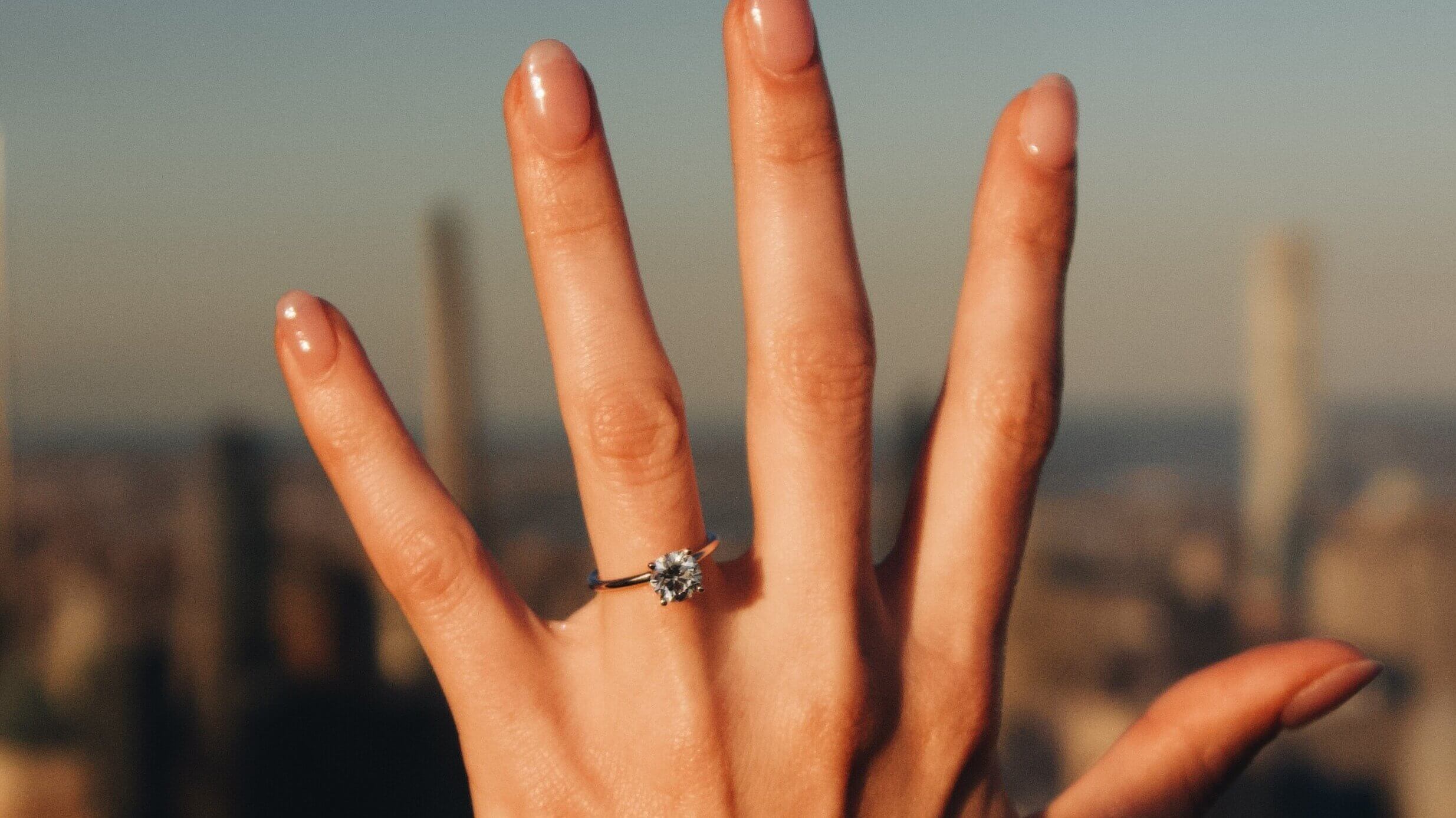
Gold Color: White Gold
The polar opposite to the warmth and richness of yellow and rose gold, white gold is an excellent choice for women who prefer sterling silver and platinum over colored metal.
White Gold with White Diamonds
The white of the metal highlights the flashes of fire emitted as the diamond moves under the light.
The effect is, of course, totally different to the one created by rose or yellow gold. While these metals blend more naturally against the skin of the wearer, white gold, and platinum blend more naturally against the diamond. Both create a contrast – the former against the diamond and the latter against the skin – and neither one is considered to be better than the other.
This Emerald Twisted Engagement Ring in White Gold is a prime example of the simple power of cohesion. While the white gold blends with the diamonds, that balance is continually interrupted by the sparks of brilliance and fire created by each stone.
White Gold vs Platinum
While they may look similar, these are two totally different metals – although, admittedly, featuring similar appearances – platinum is often the more expensive choice, although it’s also more durable.
Of all the metals out there, only platinum has proven itself capable of rivalling – and even sometimes surpassing – gold in terms of social status and prestige. It’s also a highly popular choice for engagement rings thanks to its bright, almost-luminescent appearance and strength.
You can read our guide to platinum rings for more information on this metal. Both options offer their own benefits, although the biggest drawback to platinum – and the reason so many people opt for white gold – is its high price since it is generally used at a purity of around 95% – 98%, rather than at lower karat types like gold.
Ethical Considerations in Gold Sourcing
There is more to the subject of buying gold than picking between 10K and 14K or rose or yellow. As a shopper, making informed choices means knowing what those choices are ahead of time, and that is just as pressing a subject for gold as it is for diamond.
Why? Because, like diamonds – or any other natural resource – buying gold is a process that shoppers should approach mindfully, in order to make the most responsible choices possible. We all want to be able to create the most ethical engagement rings we can, and that means that picking an ethical, conflict-free diamond only represents half the story.
Mining gold is an intensive process, just as it is for mining diamonds. Historically, human exploitation and environmental damage have been a major cause for concern in the world of gold mining. Anywhere where there is a massive potential for wealth, there is a high risk of dangerous working conditions for those responsible for recovering it.
Responsible Gold Sourcing
If gold has been responsibly sourced, then that means it has been mined or recovered from nature with an appropriate level of concern and care for the workers involved in mining it, and for the surrounding environment.
Gold rushes represent periods of rapid economic development throughout history, but also war, greed, and exploitation. Without the right frameworks in place, it is all too easy for unethical and irresponsibly sourced gold to flood the global marketplace. Many gold mining areas are found in remote locations, where, historically, it has been easier for exploitation and greed to take control.
Thankfully, many campaigns, networks, and third-party certifications have been established to ensure that shoppers can make the right choice, fully aware of the facts, instead of feeling as though they have to leave their decision up to chance. This is, thankfully, exactly how the diamond industry evolved away from a high concentration of blood diamonds on the global market, and it’s the reason why shoppers in the US don’t need to feel as though they are unwittingly funding conflict, child labor, and worker exploitation.
Recycled gold is also easier to access than it was in the past, although whether or not it’s a better (more ethical) choice than Fairtrade or Fairmined gold is up for debate…
Certifications and Ethical Standards
Meaning Chain-of-Custody, it confirms that the metal used in that piece of jewelry is conflict-free and responsibly sourced.
The Responsible Jewelry Council (RJC) has also had a strong impact on the global jewelry and fine industries, and holds their members to a strict code of practices that covers every aspect of the creation of jewelry – from mine to the jeweler’s bench. It was first founded back in 2005 and helped to rebuild trust in an industry that was, at the time, rocked by a number of high-profile humanitarian crises.
Vendors who are members of the RJC must adhere to a high standards, designed to ensure that the jewelry industry’s influence is a positive one, and that shoppers can trust in the information their jewelers are giving them.
Many jewelers are now members of the RJC. Our own jewelery maker, A.Jaffe practices full transparency around their methods for sourcing materials – whether diamond or gold, platinum, or any other natural resource. We will always be willing to answer your questions and offer you all the information you could need to make an informed decision.
Open-pit, underground, placer, and in-situ mining are the four main types of mining. Besides developing standards, expanding access to gold, and addressing adoption barriers, the World Gold Council aims to stimulate demand for gold and support the future sustainability of the gold market.
Gold Wedding Bands
An engagement ring is only capable of telling half the story – the rest needs to be completed by two wedding bands, designed with their intended wearers in mind…
old: The Traditional Choice
Gold has been used as a symbol of romantic commitment in many parts of the world for millennia, but other metals hold no less significance for married couples.
Many precious metals are now used for bridal jewelry and wedding bands, including gold, platinum, and palladium. Your choice on this matter should come down to personal preference, rather than tradition, since it is something you will be wearing every day for the rest of your life.
So, while we’re on the subject…

Maintenance and Care of Gold Rings
Even the strongest metal needs a little care, but gold is a pretty low-maintenance choice for any bride or groom.
Cleaning and Caring for Gold Jewelry
Regular cleans and, for white gold, replating will ensure your gold engagement ring or wedding band lasts a very, very long time on your finger.
Solid gold is relatively easy to maintain and is capable of lasting decades – or even longer – with the right care. In fact, white gold is widely considered to be lower maintenance than platinum, since platinum requires more regular polishes to ensure the surface remains smooth and shiny.
For any gold ring, a regular soak in some warm water and a drop of mild dish soap, followed by a soft-bristled toothbrush, is the best way to ensure it remains shiny. This is a gentle enough cleaning routine for any gold jewelry – including a diamond engagement ring.
You should also ensure to get an official check on the prongs every once in a while – at least once a year, or more frequently if time allows.
Our Expert Take
Thousands of years of human history can’t be wrong on this fact: gold is a deeply meaningful, beautiful, and durable option for any couple making the ultimate commitment to one another.
If you’ve read this far, chances are that you’re pretty serious about popping the question with gold. It’s one of the few metals considered special enough to hold a diamond, and always a strong choice, whether your bride favors neutral white and silver, warm yellow, or romantic pink.
Provided you pick a winning diamond – and, of course, a talented jeweler – we’re pretty sure you couldn’t possibly falter with gold.
7 FAQs
- Q: What Makes Gold Engagement Rings Special?
- A: Gold engagement rings are cherished for their timeless appeal, rich history, and versatility in design. They symbolize tradition and enduring love, making them a popular choice for couples.
- Q: Can Gold Engagement Rings Be Resized?
- A: Yes, most gold engagement rings can be resized. However, the ease of resizing depends on the ring’s design and the amount of resizing needed.
- Q: How Do I Choose the Right Karat for a Gold Engagement Ring?
- A: The choice depends on personal preference and lifestyle. Higher karat gold (like 22K) is purer but softer, while lower karats (like 14K or 10K) are more durable. Consider daily activities and maintenance when choosing.
- Q: Are Yellow or Rose Gold Engagement Rings Tacky?
- A: No, they are not tacky. The choice of gold color is a matter of personal taste. Both yellow and rose gold have unique aesthetics and have been popular choices for their warmth and romantic appeal.
- Q: How Do I Care for My Gold Engagement Ring?
- A: Regular cleaning with a soft cloth and mild soap, avoiding harsh chemicals, and removing the ring during heavy physical activities can maintain its shine and prevent damage.
- Q: Is White Gold More Expensive Than Yellow Gold?
- A: The price of white gold and yellow gold is generally similar. The cost may vary slightly due to the alloys used and the ring’s design, but not significantly because of the gold color.
- Q: How Can I Tell If My Gold Engagement Ring is Real?
- A: Look for a hallmark or stamp on the inside of the ring that indicates the karat. You can also have it tested by a professional jeweler for authenticity.
FOLLOW-UP GUIDE SERIES

